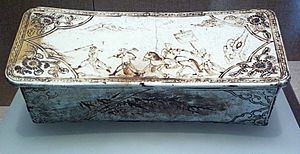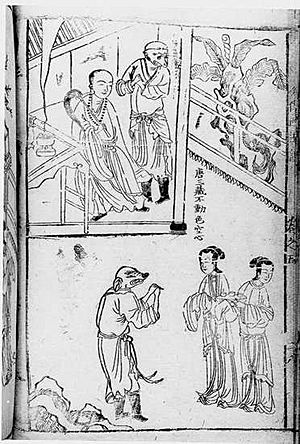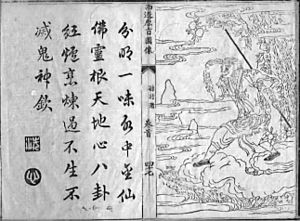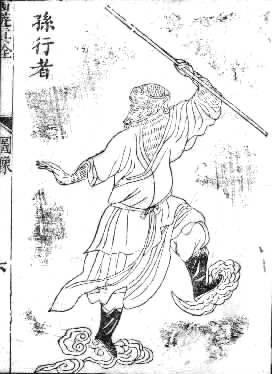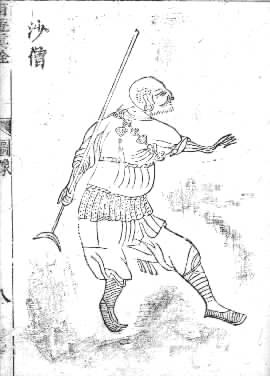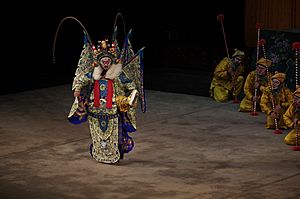Journey to the West facts for kids

Earliest known edition of the book from the 16th century
|
|
| Author | Wu Cheng'en |
|---|---|
| Original title | 西遊記 |
| Country | Ming China |
| Language | Chinese |
| Genre | Gods and demons fiction, Chinese mythology, fantasy, adventure |
| Set in | China, 7th century AD |
|
Publication date
|
c. 1592 (print) |
|
Published in English
|
1942 (abridged) 1977–1983 (complete) |
| 895.1346 | |
|
Original text
|
西遊記 at Script error: The function "name_from_code" does not exist. Wikisource |
| Journey to the West | |||||||||||||||||||||||||||
|---|---|---|---|---|---|---|---|---|---|---|---|---|---|---|---|---|---|---|---|---|---|---|---|---|---|---|---|

Journey to the West in Traditional (top) and Simplified (bottom) Chinese characters
|
|||||||||||||||||||||||||||
| Traditional Chinese | 西遊記 | ||||||||||||||||||||||||||
| Simplified Chinese | 西游记 | ||||||||||||||||||||||||||
| Literal meaning | "West Journey Record" | ||||||||||||||||||||||||||
|
|||||||||||||||||||||||||||
Journey to the West (Chinese: 西遊記; pinyin: Xī Yóu Jì; Wade–Giles: Hsi1 Yu2 Chi4) is a famous Chinese novel. It was first published around the 16th century during the Ming dynasty. Many people believe Wu Cheng'en wrote it. This book is one of the greatest Classic Chinese Novels and is super popular in East Asia. In English-speaking countries, a shorter version from 1942 called Monkey by Arthur Waley is well-known.
The story is a long adventure about a Tang dynasty Buddhist monk named Xuanzang. He travels to the "Western Regions" (which means Central Asia and India) to find important Buddhist texts called sūtras. He faces many challenges and hardships on his journey. In the novel, the monk is called Tang Sanzang. The book follows the basic idea of Xuanzang's real-life travels, which he wrote about in Great Tang Records on the Western Regions. But the novel adds exciting folk tales and made-up parts.
In the story, Gautama Buddha gives the monk this important task. Buddha also gives him three special helpers. These helpers agree to join the monk to make up for their past mistakes. The disciples are Sun Wukong, Zhu Bajie, and Sha Wujing. A dragon prince also joins them, turning into Tang Sanzang's white horse. This group of travelers works together to reach enlightenment.
Journey to the West has strong connections to Chinese folk religion, Chinese mythology, Confucianism, Taoist, and Buddhist ideas. The gods and spirits in the book still show how some Chinese people think about religion today. The novel is always popular. It's a funny adventure, a clever satire (a story that makes fun of something) about Chinese government, a source of spiritual ideas, and a long allegory (a story with a hidden meaning).
Contents
Who Wrote Journey to the West?
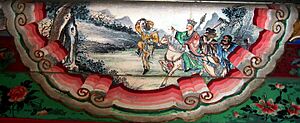
The first full version of Journey to the West was printed in 1592. Nobody knew who wrote it at the time. Before this, there were two shorter versions. It's also tricky because many parts of the story were already popular folk tales. Experts have argued for nearly a century about who wrote the novel.
In 1942, a scholar named Hu Shih thought that Wu Cheng'en wrote the book. He said that people in Wu's hometown believed he wrote it. They even had records from 1625 that said so. Hu Shih felt this meant Journey to the West was one of the first Chinese novels with a known author.
However, newer studies question this idea. In 1983, David Lattimore, a Chinese literature expert, said that the old records only mentioned Wu wrote The Journey to the West, not necessarily the novel we know. It could have been a different version of the story or something else entirely. Another translator, W. J. F. Jenner, pointed out that the novel doesn't have any political details that a well-read person wouldn't already know.
The main plot of Journey to the West was already part of Chinese folk stories. These stories were told in everyday language. There was also a poetic short story and a six-part play series. These were written down before the current novel was created.
No matter who wrote it, Journey to the West became the most important version of these folk stories. Wu Cheng'en's name is now famous because of the book.
The Real Journey: Historical Background
The novel Journey to the West is based on real history. Xuanzang (602–664) was a monk in China. He left the capital city of Chang'an in 629. He wanted to find better translations of Buddhist scriptures. He traveled even though the emperor had banned travel.
With help from other Buddhists, he went through parts of China. Then he crossed areas that are now Kyrgyzstan, Uzbekistan, and Afghanistan. In 630, he reached Gandhara in what is now northern Pakistan. Xuanzang spent the next thirteen years traveling all over India. He visited important Buddhist places, studied at a famous university, and debated with others.
Xuanzang left India in 643 and returned to Chang'an in 646. Even though he had broken the travel ban, Emperor Taizong welcomed him warmly. The emperor gave Xuanzang money and help for his projects. Xuanzang helped build the Big Wild Goose Pagoda. This pagoda was used to store the scriptures and statues he brought back from India. He wrote about his journey in a book called Great Tang Records on the Western Regions.
With the emperor's support, he started a center to translate the scriptures. His translation work helped create a new school of Buddhism. Xuanzang died on March 7, 664. A monastery was built in 669 to hold his ashes.
Long before the novel, popular stories about Xuanzang's journey already included a monkey character. These stories go back to the Southern Song dynasty. The amazing powers of Sun Wukong and other characters were seen as "magic" when Journey to the West was written.
What Happens in the Story?
The novel has 100 chapters, split into four main parts.
Sun Wukong's Early Adventures
The first part (chapters 1–7) is an introduction to the main story. It focuses on the early life of Sun Wukong, the Monkey King. He is born from a stone. He learns special skills like the art of Tao, 72 ways to change his shape, fighting, and how to live forever. He becomes so clever and strong that he calls himself "Great Sage Equal to Heaven." His powers grow to match those of the Eastern gods. This part ends with Sun Wukong rebelling against Heaven. He even gets a job in the heavenly government. But his pride leads to his downfall. The Buddha traps him under a mountain for 500 years. A special paper seal keeps him there.
Tang Sanzang's Mission
The second part (chapters 8–12) introduces Tang Sanzang. It tells his early life and why he goes on his great journey. This section also explains how Tang Sanzang becomes a monk. It reveals that he was once a disciple of the Buddha named "Golden Cicada." He is sent on this pilgrimage by Emperor Taizong. In the story, Tang Sanzang represents the human heart.
The Long Journey and Challenges
The third and longest part (chapters 13–99) is an adventure story. Tang Sanzang sets out to bring Buddhist scriptures from a temple in India. But he meets many dangers along the way. This part takes place in the wild lands along the Silk Road between China and India. The places described are mostly imaginary. Once Tang Sanzang leaves the capital city, he enters a wilderness of deep valleys and tall mountains. This land is full of demons and animal spirits. They see him as a potential meal because they believe eating his flesh will make them immortal. Sometimes, they find hidden monasteries or royal cities in this harsh setting.
Each episode usually lasts 1–4 chapters. Tang Sanzang is often captured, and his life is in danger. His disciples then try to find a clever (and often violent) way to free him. While some problems involve regular people, most are battles with different demons. Many of these demons turn out to be heavenly beings who escaped or animal spirits with enough power to look like humans.
Chapters 13–22 are a bit different. They introduce Tang Sanzang's disciples. These disciples are inspired by Guanyin (a goddess) to join him. They agree to serve him to make up for their past mistakes.
- The first disciple is Sun Wukong, the Monkey King. His name means "Monkey Awakened to Emptiness". He was trapped under a mountain by the Buddha for defying Heaven. He joins in chapter 13. He is the smartest, most powerful, and most violent of the disciples. Tang Sanzang often scolds him for being too violent. The only way to control him is with a magic gold ring around his head. This ring gives him terrible headaches when Tang Sanzang chants a special spell. In the story, Sun Wukong represents the human mind and its impulses. He is often called the "Monkey mind".
- The second disciple, joining in chapter 19, is Zhu Wuneng / Zhu Bajie. His name means "Pig Awakened to Ability" and "Eight Precepts Pig." He is sometimes called Pigsy or just Pig. He used to be a general in Heaven. He was sent to the human world for misbehaving towards the moon goddess Chang'e. He was supposed to be reborn as a human but became a half-man, half-pig monster by mistake. Zhu Bajie loves food and women. He often tries to get out of his duties, which causes arguments with Sun Wukong. In the story, Zhu Bajie represents basic human desires.
- The third disciple, joining in chapter 22, is the river ogre Sha Wujing. His name means "Sand Awakened to Purity." He is also known as Friar Sand or Sandy. He was once a general in Heaven. He was sent to the human world for accidentally breaking a crystal cup belonging to the Queen Mother of the West. He became a scary monster living in a river. Sun Wukong and Zhu Bajie helped defeat him. He then joined the group. In the story, Sha Wujing represents human obedience.
- The fourth helper is the White Dragon Horse. He is the third son of the Dragon King of the West Sea. He was going to be executed for burning his father's pearl. But Guanyin saved him. He mostly appears as the horse Tang Sanzang rides. He hardly ever speaks. In the story, the White Dragon Horse represents human will.
Chapter 22 also marks a new area. The river they cross takes them to a new "continent." Chapters 23–86 are set in the wilderness. They have 24 different adventures, each with a new magical monster or evil magician. Throughout the journey, the four disciples must protect their master, Tang Sanzang, from many monsters and dangers.
It seems that many of these problems are planned by fate or the Buddha. Even though the monsters are powerful and many, no real harm ever comes to the travelers. Some monsters turn out to be escaped heavenly creatures belonging to gods or spirits. Near the end of the book, the Buddha orders one last disaster. This is because Tang Sanzang needs 81 challenges before he can become a Buddha.
In chapter 87, Tang Sanzang finally reaches the border of India. Chapters 87–99 describe magical adventures in a more normal setting. Finally, after a journey said to have taken fourteen years, they reach their destination. It is a real and legendary place called Vulture Peak. There, in a mystical and funny scene, Tang Sanzang receives the scriptures from the living Buddha.
The Return and Rewards
Chapter 100, the last chapter, quickly describes their trip back to China. It also tells what happens to each traveler. They all receive rewards in Heaven. Sun Wukong and Tang Sanzang both become Buddhas. Sha Wujing becomes an arhat (a wise person). The White Dragon Horse becomes a nāga (a snake-like deity). Zhu Bajie, whose good deeds were always mixed with his greed, becomes an altar cleanser. This means he gets to eat the extra offerings at altars.
Main Characters of the Journey
Sun Wukong, the Monkey King
Sun Wukong (Chinese: 孫悟空) is often called the "Monkey King". His teacher gave him this name. The name means "Awakened to Emptiness." He is born on Flower Fruit Mountain from a stone egg. He first shows his bravery by entering the Water Curtain Cave. For this, his monkey tribe calls him "Handsome Monkey King." When he sees another monkey die of old age, he decides to travel the world. He wants to find a way to live forever.
He finds a teacher who teaches him 72 ways to change his shape. He also learns a "somersault cloud" that lets him travel super fast. After making several gods angry, the Jade Emperor (the ruler of Heaven) notices him. The Monkey King is given a small job in Heaven to keep an eye on him. But when Sun Wukong realizes it's the lowest job, he gets very angry. He goes back to his mountain and declares himself the "Great Sage Equal to Heaven." The Jade Emperor sends soldiers to arrest him, but they all fail.
The Jade Emperor has no choice but to make him the guardian of the heavenly peach garden. The peaches in this garden ripen every 3,000, 6,000, and 9,000 years. Eating them gives immortality. Sun Wukong eats almost all the ripe peaches. Later, fairies come to collect peaches for a banquet. They tell Sun Wukong he's not invited and make fun of him. He starts causing trouble again. He steals heavenly wine and eats Laozi's pills of immortality. He defeats an army of 100,000 heavenly soldiers.
Finally, the Jade Emperor asks the Buddha for help. The Buddha traps Wukong under a mountain after the Monkey King loses a bet. Sun Wukong is stuck under the mountain for 500 years because of a special seal. He is set free when Tang Sanzang finds him during his pilgrimage and accepts him as a disciple.
His main weapon is his staff, the "Ruyi Jingu Bang." He can shrink it to the size of a needle and keep it in his ear. He can also make it huge. The staff weighs 17,550 pounds. It was originally a pillar supporting the undersea palace of the Dragon King of the East Sea. Sun Wukong was able to pull it out easily. The Dragon King was angry, but Sun Wukong demanded armor too. The Dragon King and other dragon kings, afraid of Sun Wukong, gave him golden armor.
These gifts, along with eating immortal peaches, drinking heavenly wine, and eating Laozi's pills, make Sun Wukong the strongest member of the group. He also has a super strong body and fiery golden eyes that can see through disguises. He can pull hairs from his body and blow on them to turn them into anything he wants, usually copies of himself. He is a master of 72 transformations. He can turn into anything, living or not. However, Sun Wukong is not good at fighting underwater. So, Pigsy and Sandy often help with water battles. The Monkey King is quick and clever. He uses his skills to defeat almost all the powerful demons on the journey.
Sun Wukong's behavior is controlled by a band placed around his head by Guanyin. He cannot remove it until the journey ends. Tang Sanzang can tighten this band by chanting a special "Ring Tightening Mantra." This gives Sun Wukong terrible headaches. Tang Sanzang uses it when Sun Wukong disobeys him.
Sun Wukong is playful and sometimes impulsive, but also very cunning. This makes him a trickster hero. His funny actions bring a lighter side to the long and dangerous trip.
After the journey, Sun Wukong becomes the Victorious Fighting Buddha.
Tang Sanzang, the Monk
The monk Tang Sanzang (Chinese: 唐三藏) means "Tripitaka Master of Tang." Tang refers to the Tang dynasty, and Sanzang refers to the main Buddhist texts. He is often just called "Tripitaka" in English versions. He became a monk as a child. He set off for Tianzhu Kingdom (ancient China's name for India). He wanted to bring back original Buddhist scriptures to China.
He cannot defend himself. But the goddess Avalokiteśvara (Guanyin) helps him. She finds him powerful disciples who protect him. In return, the disciples will gain enlightenment and forgiveness for their sins. Along the way, they help local people by defeating monsters and demons. These creatures try to gain immortality by eating Tang Sanzang's flesh.
Zhu Bajie, the Pigsy
Zhu Bajie (Chinese: 豬八戒) means "Pig of the Eight Prohibitions." He is also known as Zhu Wuneng ("Pig Awakened to Power"). In English, he is called "Monk Pig", "Piggy", "Pigsy", or "Pig".
He was once an immortal general in Heaven. He commanded 100,000 naval soldiers. But he drank too much during a celebration. He then misbehaved towards the moon goddess Chang'e. Because of this, he was sent to the human world. He was supposed to be reborn as a human. But he ended up in the womb of a sow by mistake. This turned him into a half-man, half-pig monster. Zhu Bajie was very greedy and ate a lot. He lived in a cave. Guanyin told him to join Tang Sanzang's journey to India. She gave him the new name Zhu Wuneng.
At one point, he tricked a family into letting him marry their daughter. But during the wedding, he drank too much and turned back into his pig form. The villagers were scared. Zhu Bajie wanted to keep his bride. He told the bride's father he would take her by force if they didn't agree. He also locked her up. Then, Tang Sanzang and Sun Wukong arrived. They helped defeat him. Tang Sanzang renamed him Zhu Bajie, and he joined the journey.
His weapon is a "nine-tooth iron rake." He can also do 36 transformations and travel on clouds. But he is not as fast as Sun Wukong. Zhu is known for his fighting skills in water. He used these skills to fight Sha Wujing, who later joined them. He is the second strongest member of the team.
Sha Wujing, the Sandy
Sha Wujing (Chinese: 沙悟淨) means "Sand Awakened to Purity." He is called "Friar Sand", "Sand Monk", or "Sandy" in English. He was once a general in Heaven. He stood by the emperor's chariot. He was sent to the human world because he accidentally broke a crystal cup belonging to the Queen Mother of the West during a banquet.
The now-hideous immortal lived in the Flowing Sands River. He scared nearby villages and travelers. But Sun Wukong and Zhu Bajie defeated him when Tang Sanzang's group found him. They then took him on the pilgrimage to the West.
Sha Wujing's weapon is a magic wooden staff. Sometimes, drawings show him with a Monk's spade staff. He knows 18 transformation methods. He is very good at fighting in water. He is known for being the most obedient, logical, and polite of the three disciples. He always takes care of his master. He rarely argues with Sun Wukong or Zhu Bajie. He doesn't have any major flaws or amazing special traits. Because of this, he is sometimes seen as a less important character. However, he helps keep the peace in the group. He also helps Tang Sanzang make tough decisions.
At the end of the journey, he becomes an arhat. This is a higher spiritual level than Zhu Bajie, but lower than Sun Wukong and Tang Sanzang, who become Buddhas.
More Stories: Sequels and Adaptations
Other Books
A short, funny novel called Xiyoubu (Chinese: 西遊補, "A Supplement to the Journey to the West," around 1640) continues the story. It follows Sun Wukong as he gets trapped in a magical dream world. This world is created by the Qing Fish Demon, who represents desire. Sun travels through time. He becomes a judge in the Underworld and judges a traitor. He also pretends to be a beautiful woman and causes a dynasty to fall. He even fights one of his own sons. These events happen between chapters 61 and 62 of Journey to the West. The author, Dong Yue, wrote this book because he wanted to create an enemy that Sun Wukong couldn't defeat with just his strength.
English Translations
Over the years, Journey to the West has been translated into English in different ways.
- Monkey: A Folk-Tale of China (1942) is a shorter translation by Arthur Waley. For many years, this was the most famous English version. Waley chose to leave out many parts but translated the remaining ones almost completely. He also left out most of the poems. Some critics say it's more of a good retelling than a full translation. Others praise it for staying true to the original spirit of the work.
- In 2006, a shorter version of Anthony C. Yu's translation was published as The Monkey and the Monk.
- Julia Lovell also translated selected chapters into lively, modern English.
There are also complete, unabridged translations:
- The Journey to the West (1977–83) is a full translation in four volumes by Anthony C. Yu. This was the first to translate the poems and songs, which Yu believes are key to understanding the author's meaning. Yu also added a lot of scholarly notes. A revised edition came out in 2012.
- Journey to the West (1982–84) is another complete translation in four volumes by William John Francis Jenner. It is easy to read and doesn't have scholarly notes.
Movies, TV Shows, and Games
The story has been made into many movies, TV shows, and games.
- Saiyūki (also known as Monkey) was a Japanese TV series from 1978 to 1980. It was translated into English by the BBC.
- In the 1980s, China Central Television (CCTV) made a popular TV show with the same name. A second season was made later to cover parts the first season missed.
- In 1988, the Japanese anime Doraemon released a movie called Doraemon: The Record of Nobita's Parallel Visit to the West, based on the story.
- In 2009, a video game called Enslaved: Odyssey to the West was released. It was developed by Ninja Theory and published by Bandai Namco Entertainment. The main character, Monkey, is voiced by Andy Serkis.
- On April 20, 2017, TV channels in Australia and New Zealand, along with Netflix, announced a new live-action TV series called The New Legends of Monkey. It premiered in 2018. The series has 10 episodes. Some people liked it, but others criticized it for not having Chinese actors in the main roles.
- In 2017, Viki and Netflix hosted a South Korean show called A Korean Odyssey. It's a modern comedy version that starts with Sun Wukong being released and Tang Sanzang being reborn.
- In August 2020, Game Science Studios announced a video game called Black Myth: Wukong.
- On May 16, 2020, The Lego Group released a toy theme called Lego Monkie Kid. Journey to the West was the main inspiration for it. Many characters from the original story are featured. An animated TV series pilot was released on May 20 to go with the toys. The series started airing in September 2020.
See also
 In Spanish: Viaje al Oeste para niños
In Spanish: Viaje al Oeste para niños
- Dragon Ball
- Dream of the Red Chamber
- One Piece
- Enslaved: Odyssey to the West
- The God of High School
- Romance of the Three Kingdoms
- Saiyuki
- Starzinger
- Water Margin



